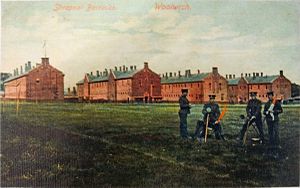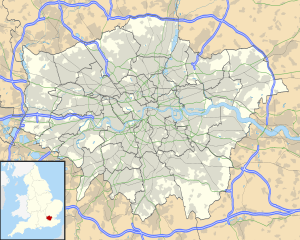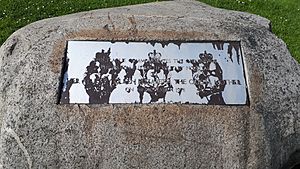Shrapnel Barracks facts for kids
Quick facts for kids Shrapnel Barracks |
|
|---|---|
| Woolwich | |
 |
|
|
Location within London
|
|
| Coordinates | 51°28′44″N 0°03′04″E / 51.4789°N 0.0511°E |
| Type | Barracks |
| Site information | |
| Owner | Ministry of Defence |
| Operator | |
| Site history | |
| Built | c.1853 |
| In use | c.1853-c.1965 |
The Shrapnel Barracks was a British army base in Woolwich, southeast London. It provided homes for soldiers from the mid-1800s until the 1960s. The barracks was named after Lieutenant General Henry Shrapnel. He invented the shrapnel shell and worked nearby at the Royal Arsenal. Today, the Queen Elizabeth Hospital stands where the barracks used to be.
History
Early Days
The Shrapnel Barracks started as a "hutted camp" around 1853. This was during the Crimean War (1853-1856). It was a base for cavalry units, which are soldiers who fight on horseback. The camp was known as 'Hut Barracks' on old maps. Next to it was the Royal Horse Infirmary, a hospital for army horses. There were also many stables nearby.
Duke of York's Cottages
Before the barracks, there were rows of huts on the common. These were built by married artillerymen in the early 1800s. They needed homes for their families. About a thousand married soldiers had no official housing. These "mud huts" were later replaced by the government.
The new homes were simple, single-room dwellings. There were 100 of them, arranged in pairs. They were built along the road to Charlton. Soldiers paid a small rent for these homes. Later, more homes were built for married non-commissioned officers (NCOs). An infant school was also added for the children. This area was called the "Duke of York's Cottages." But people still called them "the Huts."
These homes became very crowded and unhealthy. After a sickness outbreak, they were torn down in the late 1870s. In 1887, a new building for training and getting army horses was built there. This was called the Army Remount Service.
Later History
In 1896, a new barracks was built and named Shrapnel Barracks. Plans for these new buildings are kept at the National Archives. These barracks housed a brigade of field artillery, which are soldiers who use large guns. The site also had a riding school and new stables for horses.
The old Hut Barracks seemed to stay in use too. In 1912, a writer described the area. He mentioned the horse depot, the new Shrapnel Barracks, the old hut barracks, and the horse hospital. The 1911 census showed 567 people living in "Shrapnel Barracks and Huts."
In 1910, the barracks changed its purpose. It became the No. 1 (Eastern) Cavalry Depot. This meant it was a main base for cavalry soldiers. New buildings were planned, including an officers' mess and quarters. The cavalry depot was used during the First World War. After the war, it went back to housing field artillery.
During the Second World War, the barracks was a place where artillery regiments gathered before going to fight. An anti-aircraft battery was built nearby in 1940. This battery had large guns to shoot down enemy planes. It helped protect southeast London. In 1944, it was upgraded with more powerful guns. On October 28, 1944, a V-2 rocket exploded above the barracks. Luckily, no one was hurt.
The Royal Artillery and the Women's Royal Army Corps used the barracks. It was torn down in the 1960s.
Hospital Site
After the barracks was demolished, a new hospital was built on the site. It was called the Queen Elizabeth Military Hospital. Construction started in 1972, and the hospital opened in 1977. It was officially opened on November 1, 1978. The hospital had 456 beds. It cared for soldiers and their families. It also helped Chelsea Pensioners and people who were prisoners of war in the Far East. Local civilians could also get care there.
The hospital closed in 1995 due to government defense cuts. In March 2001, it reopened as the Queen Elizabeth Hospital. It was later rebuilt and made bigger in 2006. Some original parts, like the main entrance, are still there. A road near the hospital, Shrapnel Close, reminds people of the old barracks.
Notable People
Some well-known people were connected to Shrapnel Barracks:
- Spike Milligan's father, Leo, joined the army there in 1904. He was a boy soldier in the Royal Artillery.
- Journalist Bill Deedes was stationed there for a short time in 1940.
- Terence Thomas, Baron Thomas of Macclesfield was also stationed at Shrapnel Barracks in the 1950s.



